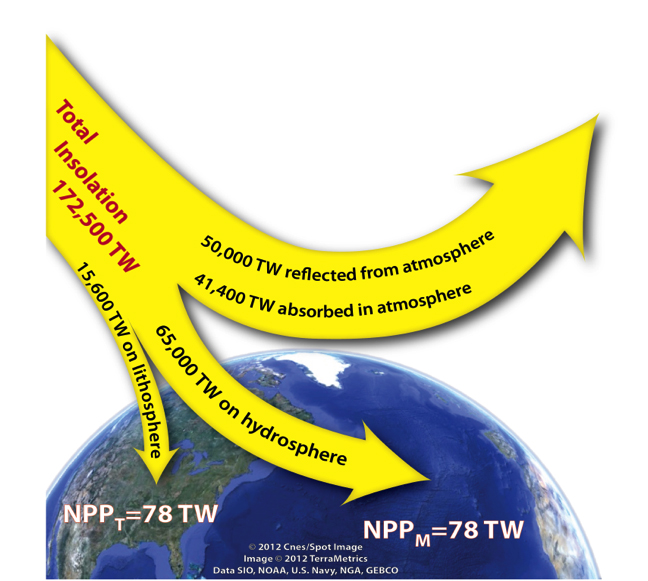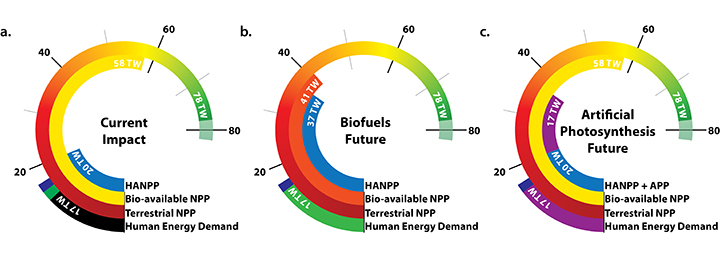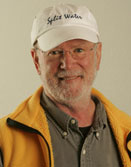 |
The belief that we have abundant solar energy to power all our needs is not necessarily correct. This excerpt takes a critical look at the idea of the abundance of solar energy and shows the problems with such conclusions. It is taken from an article currently in press at Photosynthesis Research
Evolution of reaction center mimics to systems capable of generating solar fuel
Benjamin D. Sherman, Michael D. Vaughn, Jesse J. Bergkamp, Devens Gust, Ana L. Moore, Thomas A. Moore.
Department of Chemistry and Biochemistry, Arizona State University, Tempe, AZ 85287;
Center for Bioenergy and Photosynthesis, Arizona State University, Tempe, AZ 85287; Center for Bio-Inspired Solar Fuel Production, Arizona State University, Tempe, AZ 85287
Introduction
Human activity and especially our reliance on burning fossil fuels has affected planet wide systems, resulting in a precarious future for the global ecosystem (Rockström et al. 2009). The magnitude of the energy reaching the Earth from the sun makes solar energy conversion a likely part of any alternative energy future that does not rely on the use of fossil fuel yet still satisfies society’s energy demand (Armaroli and Balzani 2007). The immense scale of solar irradiance, however, means little without an efficient means of converting it to useful forms such as electricity or an energy-dense and transportable fuel. Developing a system for converting an abundant and readily available precursor into a fuel using solar radiation as the sole energy input is the primary goal of artificial photosynthesis (Bard and Fox 1995; Gust et al. 2009).

The motivation for and possible impact of the wide scale use of artificial photosynthesis to meet human societal energy needs can be illustrated with reference to Fig. 1. Taking into account reflection and absorption of light by the atmosphere, around 65,000 TW reaches the hydrosphere and 15,600 TW reaches land (Sorensen 2010). Photosynthesis converts a portion of this irradiance into energy stored in reduced carbon, with the net amount of biomass produced in a year (net primary production, NPP) totaling ~112 Pg of fixed carbon (Ito 2011). Converting this amount of reduced biomass produced per year to a rate of energy conversion using the conversion factor of 41.3 KJ g-1 of fixed carbon (Archer and Barber 2004) yields an average rate of ~156 TW, evenly distributed between terrestrial and marine production (Cramer et al. 1999; Field et al. 1998; Ito 2011). This biomass in turn supports nearly all life on the planet. Humans consume an increasing portion, currently ~25% (Haberl et al. 2007). An important issue we face is that human appropriation of net primary production (HANPP) comes at the expense of the remainder of biology, and continued population growth will increase the human demand on NPP for food and material. The conversion of land to support HANPP is thought to be driving several Earth systems over boundaries established by natural cycles operating on the geological time scale (Barnosky et al. 2012; Rockström et al. 2009).

Therefore, any solar-to-fuel system must be vetted against its impact on HANPP; an increase will accentuate an already tenuous ecological situation (Barnosky et al. 2012; Rockström et al. 2009). Figure 2 outlines energy accounts comparing terrestrial NPP, HANPP, the remainder of NPP after human harvest, and the current non-food energy consumption of modern society. Part (a) illustrates the current state: the human requisition of NPP sums to 20 TW (Haberl et al. 2007). Driving the global gross domestic product currently consumes ~17 TW, mainly supplied by fossil fuels (IPCC 2011). Fully displacing fossil fuels with crop-derived biofuel, as shown in (b), must come directly out of NPP. Though carbon neutral, such a scenario is not sustainable as HANPP would increase to nearly 50% NPP. Such a substantial consumption of the total available terrestrial biomass would likely upend the balance of life on the planet as it has been known for the entirety of human existence. Alternatively, as shown in (c), an artificial photosynthetic system (possibly including a synthetic biological organism or photosynthetic microbe whose culture does not displace native organisms or crops) could supply human energy needs while not depleting the biomass needed to support the global ecosystem. We term this converted solar energy APP or artificial photosynthetic production. This situation would have to satisfy several caveats. For instance any such system should occupy surface area already altered by human activity and minimize the amount of additional land converted for human use. This basic argument seeks not only to focus just on the surface footprint needed to convert solar irradiance to forms of energy usable by humans, but also to consider that any system should not compete for sunlight or land currently used for food production or accessible to nature. To do so will only increase HANPP and further endanger the stability of the global ecosystem.
In order to exceed current productivity without increasing HANPP, the field of artificial photosynthesis seeks the development of solar-to-fuel systems capable of converting light energy to chemical energy stored in a dense, transportable fuel with efficiencies much greater than those of natural photosynthesis. Such a system, as opposed to that of solar-to-electricity (photovoltaic cells), allows for the storage of solar energy and separates its points of generation and utilization in both time and space. As such, artificial photosynthesis can provide a direct substitute for fossil fuels, which are ideal energy carriers with respect to their high energy densities and easy transport. Although designing and constructing such a system comes with enormous challenges, the natural process of oxygenic photosynthesis offers us a guide.
References:
Archer MD, Barber J (2004) Molecular to global photosynthesis. Imperial College Press, London
Armaroli N, Balzani V (2007) The future of energy supply: challenges and opportunities. Angew Chem Int Ed Engl 46:52–66. doi:10.1002/anie.200602373
Bard AJ, Fox MA (1995) Artificial photosynthesis: solar splitting of water to hydrogen and oxygen. Acc Chem Res 28:141–145. doi:10.1021/ar00051a007
Barnosky AD, Hadly EA, Bascompte J et al (2012) Approaching a state shift in Earth’s biosphere. Nature 486:52–58. doi:10.1038/ nature11018
Cramer W, Kicklighter DW, Bondeau A et al (1999) Comparing global models of terrestrial net primary productivity (NPP): overview and key results. Glob Chang Biol 5:1–15. doi:10.1046/ j.1365-2486.1999.00009.x
Field CB, Behrenfeld MJ, Randerson JT, Falkowski P (1998) Primary production of the biosphere: integrating terrestrial and oceanic components. Science 281:237–240
Gust D, Moore TA, Moore AL (2009) Solar fuels via artificial photosynthesis. Acc Chem Res 42:1890–1898. doi:10.1021/ ar900209b
Haberl H, Erb KH, Krausmann F et al (2007) Quantifying and mapping the human appropriation of net primary production in Earth’s terrestrial ecosystems. Proc Natl Acad Sci USA 104:12942–12947. doi:10.1073/pnas.0704243104
Ito A (2011) A historical meta-analysis of global terrestrial net primary productivity: are estimates converging? Glob Chang Biol 17:3161–3175. doi:10.1111/j.1365-2486.2011.02450.x
Rockström J, Steffen W, Noone K et al (2009) A safe operating space for humanity. Nature 461:472–475. doi:10.1038/461472a
Sorensen BS (2010) Renewable energy, fourth edition: physics, engineering, environmental impacts, economics & planning. Academic Press, Oxford
|
A transdisciplinary center affliated with College of Liberal Arts and Sciences Ira A. Fulton School of Engineering
|
Center for Bioenergy & Photosynthesis Arizona State University, Box 871604, Room ISTB-5 101, Tempe, AZ 85287-1604 phone: (480) 965-1963, fax: (480) 965-5927 26-Jun-2013 |

